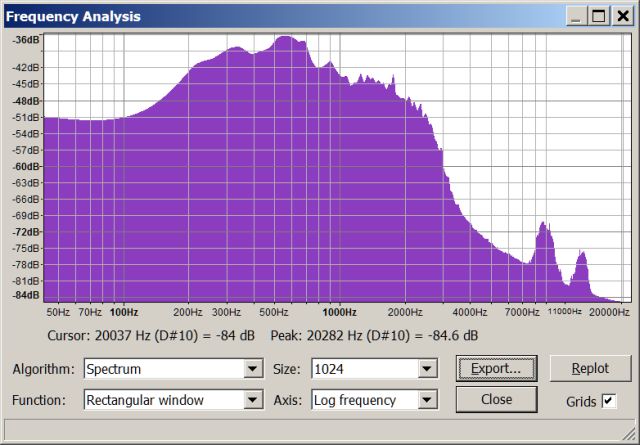Friday, March 31, 2017
MTBF
How many wiggles does an eardrum make during its lifetime? There's no way to pin it down, but my predictable little life makes it somewhat easier to estimate. Because I've always had tinnitus, I've always avoided silence. A radio or an OTR clip is playing in the background most of the time, asleep or awake.
I loaded a typical OTR program (a Ripley's episode with good clear unclipped sound) into Audacity and ran a spectrum on a long stretch including male and female voices and music. The spectrum showed a definite peak around 500 cps, so we'll take that as representative.
 I'm 67 years old. I started noticing tinnitus and adding noise around age 7. There were a few scattered years when I had to use earplugs instead of background because of noisy neighbors. So we'll take 50 years of full-time sound as a low estimate and a round number.
One day of 500 cps = 86400 seconds * 500 cycles per second = 43,200,000 eardrum wiggles in a day. A year endures 15.7 billion wiggles, and 50 years sum up to 788 billion wiggles overall. Still going strong. Other parts of the auditory system are aging, but not from mechanical motion.
How many mechanical systems can handle a trillion moves without failing? Living tissue wins.
Of course the comparison is totally unfair in one way. All the stuff around me has been exposed to the same sound, and the more flexible objects (cardboard, window glass, sheet metal) have been vibrating in the same tiny amplitude as the eardrum for the same period of time, without being affected in the slightest. The real distinction is not the movement itself but the maintenance of precisely calibrated parameters in the auditory system. The tympanic membrane and the three ossicles have held the same damping and elasticity through a trillion wiggles.
I'm 67 years old. I started noticing tinnitus and adding noise around age 7. There were a few scattered years when I had to use earplugs instead of background because of noisy neighbors. So we'll take 50 years of full-time sound as a low estimate and a round number.
One day of 500 cps = 86400 seconds * 500 cycles per second = 43,200,000 eardrum wiggles in a day. A year endures 15.7 billion wiggles, and 50 years sum up to 788 billion wiggles overall. Still going strong. Other parts of the auditory system are aging, but not from mechanical motion.
How many mechanical systems can handle a trillion moves without failing? Living tissue wins.
Of course the comparison is totally unfair in one way. All the stuff around me has been exposed to the same sound, and the more flexible objects (cardboard, window glass, sheet metal) have been vibrating in the same tiny amplitude as the eardrum for the same period of time, without being affected in the slightest. The real distinction is not the movement itself but the maintenance of precisely calibrated parameters in the auditory system. The tympanic membrane and the three ossicles have held the same damping and elasticity through a trillion wiggles.
 I'm 67 years old. I started noticing tinnitus and adding noise around age 7. There were a few scattered years when I had to use earplugs instead of background because of noisy neighbors. So we'll take 50 years of full-time sound as a low estimate and a round number.
One day of 500 cps = 86400 seconds * 500 cycles per second = 43,200,000 eardrum wiggles in a day. A year endures 15.7 billion wiggles, and 50 years sum up to 788 billion wiggles overall. Still going strong. Other parts of the auditory system are aging, but not from mechanical motion.
How many mechanical systems can handle a trillion moves without failing? Living tissue wins.
Of course the comparison is totally unfair in one way. All the stuff around me has been exposed to the same sound, and the more flexible objects (cardboard, window glass, sheet metal) have been vibrating in the same tiny amplitude as the eardrum for the same period of time, without being affected in the slightest. The real distinction is not the movement itself but the maintenance of precisely calibrated parameters in the auditory system. The tympanic membrane and the three ossicles have held the same damping and elasticity through a trillion wiggles.
I'm 67 years old. I started noticing tinnitus and adding noise around age 7. There were a few scattered years when I had to use earplugs instead of background because of noisy neighbors. So we'll take 50 years of full-time sound as a low estimate and a round number.
One day of 500 cps = 86400 seconds * 500 cycles per second = 43,200,000 eardrum wiggles in a day. A year endures 15.7 billion wiggles, and 50 years sum up to 788 billion wiggles overall. Still going strong. Other parts of the auditory system are aging, but not from mechanical motion.
How many mechanical systems can handle a trillion moves without failing? Living tissue wins.
Of course the comparison is totally unfair in one way. All the stuff around me has been exposed to the same sound, and the more flexible objects (cardboard, window glass, sheet metal) have been vibrating in the same tiny amplitude as the eardrum for the same period of time, without being affected in the slightest. The real distinction is not the movement itself but the maintenance of precisely calibrated parameters in the auditory system. The tympanic membrane and the three ossicles have held the same damping and elasticity through a trillion wiggles.Labels: Metrology
